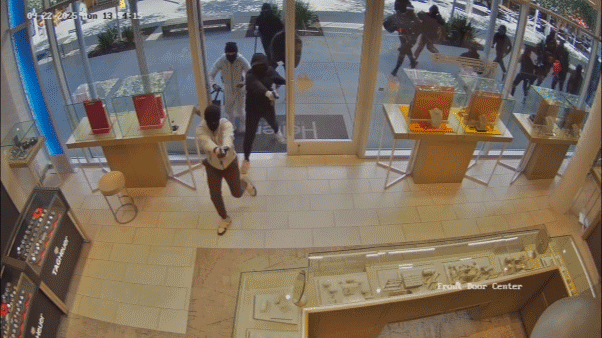Jewelry Store Heist Highlights California’s Ongoing Retail Crime Crisis
In a shocking display of organized retail crime, nearly two dozen masked thieves orchestrated a violent smash-and-grab robbery at Heller Jewelers in San Ramon, California on Monday. Surveillance footage captured the terrifying scene as the mob stormed into the Bay Area store, wielding hammers and pickaxes to shatter display cases while employees watched in horror. The brazen attack escalated when at least one suspect fired a shot through the front entrance, while others pointed firearms directly at staff members. Within minutes, the thieves had stolen approximately $1 million in merchandise before escaping in vehicles that were strategically positioned in the City Center Bishop Ranch valet parking area. Though police pursued the suspects, they eventually pulled back to allow helicopters to track the fleeing vehicles, resulting in the detention of several suspects in Oakland and a nearby suburb, including brothers Jimmy Ray, 27, and Michael Ray.
This alarming incident isn’t isolated, but rather part of a troubling pattern plaguing California retailers. Just two weeks earlier, an 88-year-old jewelry shop owner in San Jose fell victim to a similar attack that left her injured and her store devastated. Surveillance video from Kim Hung Jewelry captured the moment when thieves backed an SUV through the store’s glass windows before more than a dozen individuals poured in and ransacked display cases. The elderly owner, shoved to the ground during the chaos, is still recovering from her injuries—a sobering reminder of the human toll these crimes take beyond just financial losses. These incidents represent a growing crisis that combines property crime with increasingly dangerous elements of violence and intimidation, leaving business owners and employees traumatized and communities on edge.
The rising tide of organized retail theft has prompted California to take more aggressive action through its dedicated Organized Retail Crime Task Force. Led by the California Highway Patrol (CHP), this specialized unit has been working to dismantle the sophisticated criminal networks behind these large-scale thefts. Their efforts have yielded significant results—as of August 2025, the task force had made over 700 arrests and recovered nearly 150,000 stolen items valued at approximately $8 million. Governor Gavin Newsom has emphasized the state’s commitment to combating these crime rings, stating, “We are serious about stamping out crime rings that target California’s businesses and undermine public safety. We appreciate the work of our law enforcement partners statewide to apprehend these bad actors.”
Despite these enforcement efforts, retailers across California continue to face an unprecedented challenge. What makes these crimes particularly concerning is their evolution from opportunistic shoplifting to highly coordinated operations involving multiple perpetrators, weapons, and getaway vehicles. The San Ramon jewelry heist demonstrates the sophistication of these networks—the suspects didn’t merely grab what they could and run; they executed a planned assault with designated roles, tools designed to quickly break through security measures, and a coordinated escape plan. Law enforcement officials note that many of these stolen goods are quickly resold through online marketplaces or fencing operations, making recovery difficult and providing a steady profit stream for criminal enterprises.
The impact extends far beyond the immediate victims. Communities suffer as businesses either close permanently or pass increased security costs on to consumers. Insurance premiums rise, affecting all retailers in high-risk areas. Some stores have responded by keeping fewer products on display, installing more extensive security systems, hiring armed guards, or in extreme cases, relocating to areas perceived as safer. Employees face increased workplace stress and safety concerns, with some reporting anxiety and reluctance to intervene during thefts for fear of violent retaliation. The psychological impact on witnesses and victims—like the elderly San Jose jewelry store owner—can be long-lasting, creating a ripple effect of trauma throughout retail communities.
Finding effective solutions requires a multifaceted approach that goes beyond just arrests. While California’s task force represents an important step, experts suggest that addressing the entire criminal ecosystem—from theft to resale—is essential. This includes stronger penalties for organized retail crime, improved coordination between jurisdictions to track repeat offenders, technology to identify stolen merchandise when it enters the resale market, and community-based initiatives to address underlying factors driving participation in these criminal networks. Retailers are also adapting with enhanced security protocols and staff training, though many small businesses lack the resources for comprehensive protection. As California continues to battle this surge in organized retail crime, the recent jewelry store heists serve as stark reminders of both the human and economic costs at stake—and the urgent need for effective interventions to protect businesses and the communities they serve.











